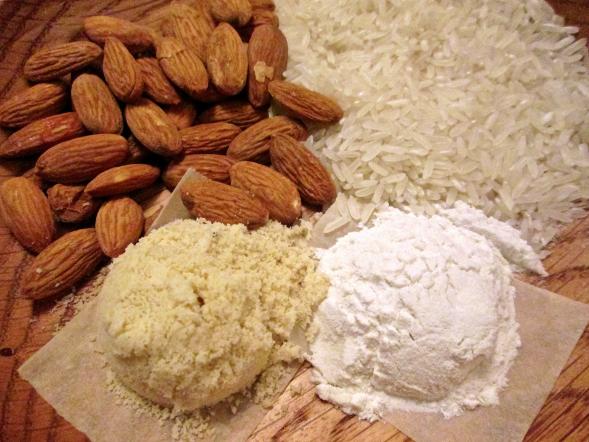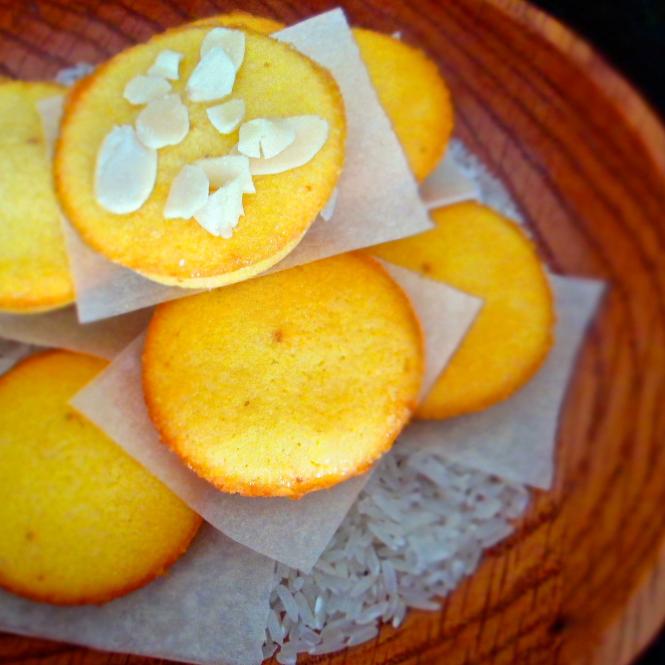In recent years, the gluten-free (GF) diet – which began as the only effective treatment for celiac disease – has gained mainstream popularity. According to a recent Mayo Clinic study, more than a million relatively healthy Americans have adopted gluten-free diets as a lifestyle choice rather than a medical necessity, despite GF’s harsh restrictions on foods made with wheat, rye, and barley (a constraint that includes pastas, beer, and practically every kind of baked good).
But in a
wacky bit of arithmetic, subtracting one variable – wheat flour – can actually result
in the addition of more options for interesting ingredients and dishes. Thanks
to the demand for gluten-free ingredients, curious bakers of every stripe can
now find a variety of flours made from tubers, seeds, and nuts to add different
flavors and textures to wheat-flour-based recipes or to replace wheat flour
altogether. And even if you’re not
gluten-free, these alternative flours are a great way to learn new recipes
or a different way of making cakes, pastries, and breads, such as steamed rice
cakes from the Philippines or savory Niçoise crèpes baked in a skillet.
Non-gluten flours used in global cuisines can now be found in local ethnic groceries and food co-ops. However, replacing wheat flour with these alternatives is not a simple one-on-one switch, especially for baking, as gluten provides the structure and texture that we look for in baked goods: a chewy loaf of bread, a tender cake crumb, or a flaky pie crust. It’s also important to remember that gluten-free flours are not as effective on their own. For best results, you’ll have to mix several non-wheat flours together with additional starches for a full gluten-free flour substitute; replace only some of the wheat flour in your favorite recipes; or use a non-gluten flour in a traditional recipe from another cuisine.
 Almond Meal and Rice Flour
Almond Meal and Rice Flour
Around the World in Four Flours
To get you started, here are four non-gluten flours commonly used around the world:
Cassava flour is a staple in Central and South American cuisines, where it is often made into bread. Brazil, in particular, makes great use of it in delicious, chewy cheese rolls called pão de queijo and in farofa, toasted cassava flour served as a side dish. In West Africa, a similar cassava flour called garri is also used to make a polenta-like side dish.
Look for: manioc, mandioca, yuca, polvilho, or tapioca in Hispanic stores and fufu flour in African markets (although this may be mixed with potato and plantain flours).
Chickpea flour is an essential ingredient in Middle Eastern and South Asian cookery, and is used to make pakoras (deep fried vegetable fritters) and unleavened flatbreads called roti. In Italy and France, farinata and socca, respectively, are made by mixing chickpea flour with olive oil (and other ingredients), then baked in a skillet. Chickpea flour can be also be used in place of wheat flour in baked goods like cookies, with some adaptations.
Look for: garbanzo, gram or besan flour in Indian/South Asian groceries or your local food co-op.
Nut meals are finely ground from a variety of whole nuts, most commonly almond, hazelnut, and walnut. They are best used in conjunction with other gluten-free flours in baked goods. However, nut meals step up to the plate on their own in Central European classic flourless tortes.
Also known as nut flours, although this term generally refers to what is leftover after oil has been extracted from the nuts. Nut meals can be found in most groceries, health stores, and specialty markets, including your local food co-op, and are also easy to make at home.
Rice flour is made from finely ground white, brown, or sweet rice (also known as glutinous rice in reference to its sticky quality, not gluten content), and is used extensively in South and Southeast Asia to make noodles, roti, and sweets such as Japanese mochi and Filipino puto (steamed rice cake) and palitaw (boiled rice cake). For baking, rice flour is considered the closest to acting like wheat flour, with one notable exception: It is a poor binder. If you wish to use rice flour for a gluten-free recipe, mix it with nut meals to add needed moisture and protein.
Look for: mochiko or malagkit, as sweet rice flour is known respectively in Japanese and Filipino, at most Asian groceries. White and brown rice flours can be found in specialty food and health stores and your local food co-op.

Sweet Rice and Almond Tea Cakes
These gluten-free treats have a subtle citrus flavor and delicately moist texture that can easily be too dense and heavy if baked in a large pan. For best results, use mini-muffin or madeleine tins.
Adapted from Food52
Makes 24 cakes
 Ingredients:
Ingredients:
1/2 cup rice flour
1/4 cup almond meal
1/2 teaspoon baking powder
Pinch of salt
1/2 cup (1 stick) butter, softened
1/2 cup granulated sugar
2 eggs
1/3 cup cream cheese, softened
1 Tablespoon lime or lemon juice
1/4-cup milk
Instructions:
1. Preheat oven to 350˚F. Butter a mini-muffin or madeleine pan.
2. Whisk rice flour, almond meal, baking powder and salt until well combined and set aside. 3. Cream butter and sugar until fluffy then add eggs one at a time, mixing well after each one. Add cream cheese, juice and milk, and mix until combined. Add rice flour mixture and beat until batter is smooth.
4. Spoon batter into the pan and bake for 15 to 17 minutes or until edges of the cake are golden brown and the sides pull away from the pan.
5. Let cool before serving and store in an airtight container in the refrigerator for 3 to 5 days.
 Tracey Paska lives,
eats and writes in Manila, Philippines, where she revels in the fact
that she can wear flip-flops outdoors in January. When she's not
exploring Manila's foodscape, she freelances for a national food
magazine and writes about the complex and fascinating connections
between food, culture, and society on her blog Tangled Noodle. Follow her at @TangledNoodle. Her last article for us was Globally Aware: Shopping Outside the Big Box in the Philippines.
Tracey Paska lives,
eats and writes in Manila, Philippines, where she revels in the fact
that she can wear flip-flops outdoors in January. When she's not
exploring Manila's foodscape, she freelances for a national food
magazine and writes about the complex and fascinating connections
between food, culture, and society on her blog Tangled Noodle. Follow her at @TangledNoodle. Her last article for us was Globally Aware: Shopping Outside the Big Box in the Philippines.




